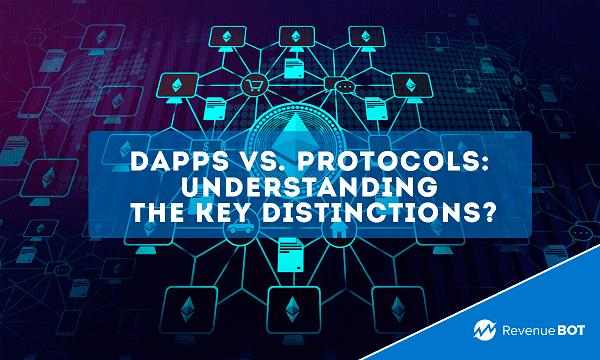
In the crypto and blockchain space, new terminology and concepts are emerging that require a straightforward definition. One such issue is the distinction between decentralized applications and protocols. Below, we will provide a comprehensive comparison of these two key aspects of the blockchain ecosystem, as well as reveal their meaning and define their role in building new digital solutions.

What are decentralized apps?
Decentralized applications (DApps, dApps, Dapps, or dapps) represent a keystone of blockchain technology as it seeks to revolutionize the way users and applications interact with each other. DApps deviate from traditional centralized applications as they operate based on decentralized protocols and contracts.

In this way, a high degree of transparency, security and autonomy in operation can be achieved. What is the main difference between dApps and traditional applications is that governance and decision-making in dApps originate from a network of nodes rather than from one central participant, thus encouraging a more democratic and peer-to-peer environment for users.
Main features
dApps possess a number of attributes that render them unique and innovative tools in the tech world:
- Decentralized nature and autonomy. dApps are capable of functioning without centralized management. They rely on blockchain and smart contracts to facilitate transactions processing and eliminate the trust in central authorities.
- Transparency. In dApps, all activity and transaction info is usually stored on a blockchain that is public and thus cannot be changed unless the majority of the network participants agree. As a result, it provides a high level of credibility between users.
- Security. Due to their decentralized nature, dApps are less exposed to attacks and hackers as there is no single central point of attack. Moreover, the smart contracts behind a lot of dApps provide a supreme level of security, as their execution is strictly dependent on the code and conditions recorded in the contract.
- Community participation: Mostly such apps are developed and maintained by a broad base of contributors, allowing for a diversity of ideas, enhanced functionality, and support for the product at a great variety of levels.
- Openness to integration: Decentralized applications are often designed to incorporate with other dApps and protocols to create complex and powerful digital ecosystems.
Blockchain protocols and their working
These play a pivotal role in the performance of blockchain-based technologies and dApps as well. Protocols are sets of rules and standards that define the way network participants interact with each other. They provide a uniform and robust experience by enabling different applications to interoperate within the same ecosystem.
- Key blockchain protocols. Here we can mention Bitcoin and Ethereum, the good old couple which nowadays defines the basic aspects of any network, including block creation, transaction validation and consensus algorithms. .
- DeFi protocols: In addition to the basic blockchain protocols, there are customized protocols designed for building and deploying decentralized applications. Such protocols as Ethereum, EOS, Cardano and others provide tools for developers to create smart contracts and implement application logic on their blockchain.
- Interoperability and standardization: In today’s blockchain ecosystem, it is becoming increasingly important to ensure operational compatibility between different protocols. It allows dApps to communicate with each other and deliver more sophisticated and beneficial solutions. Standardization can also help lower the barriers to interoperability between distinct blockchain platforms.
- Protocols as innovation catalysts: by this we mean protocols have a major impact on the development and innovation in the field of blockchain and dApps. They boost the development of new features, enhance scalability, and increase performance, resulting in more efficient and user-friendly applications.
How dApps and Protocols work together
Both dApps and protocols collectively form the backbone of the blockchain ecosystem, interactions between them plays a prominent part in creating innovative and effective solutions.
In order to function, dApps rely on protocols. They use basic blockchain protocols to store data, conduct transactions and create smart contracts .

Protocols also serve as a ground for driving innovation and development of dApps. They set norms for creating smart contracts and establishing communication between applications. Devs can utilize protocols to implement unique ideas, extend existing functionality, and improve overall performance.
As said, among the important features of the interaction between dApps and protocols is interoperability. Protocols empower dApps to interconnect to create compound ecosystems. This paves the way for collaborative solutions, data sharing, and user experience enhancement.
As such, the interoperability between dApps and protocols is an integral component of the blockchain ecosystem. They complement each other to provide the infrastructure and functionality to innovate, develop and create advanced solutions.
Conclusion
We have explored key points of communication among dApps and protocols in the context of the blockchain ecosystem. DApps powered by decentralized protocols bring a new level of transparency, security, and autonomy to users. Protocols, in turn, serve as the bedrock for the operation and development of dApps, laying out the standards for creating smart contracts and enabling interoperability.
The interplay between dApps and protocols shapes a dynamic environment for innovation and collaboration. They reinforce each other, allowing developers to embody their ideas and create complex decentralized ecosystems. Spurred by this synergy, blockchain technology keeps evolving, unlocking new perspectives for the future of the digital ecosystem.
